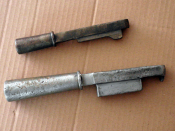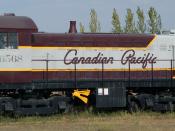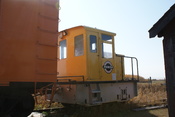1
Miller
The History of Diesel Electric Locomotives
One of the problems in the passenger train industry was the complaints from luxury cars who felt as if the tour was through a coal mine. Imagine a romantic ride on a steam train with a woman who wore a beautiful dress, that now is covered in cinders and ash; this is one of the disadvantages of steam locomotives (steam 171). Electric locomotives begin to replace steam-powered trains around 1900. Electricity provides a limitless cheap source of power run at much higher standards of efficiency, speed and cleanliness. Early experimental ventures into electric locomotives are vague without a reliable source of documentation (Haut 21).
Some electric prototypes begin development as early as 1835 but was abandoned as not practical in the steam era. More experiments followed without success until 1880 (Haut 22). Early prototypes in 1879 used 150-volt current and developed about three horse power; later development generated twelve horse power using 250 volts, and incorporated electric braking function into the traction motors (Haut 23).
About 1890 it became obvious that three-phase alternating current had advantages over directional current in trains. The main advantage is less weight and current regeneration (Haut 24). Brown, Boveri & co. of Zürich was using 750-volt 40Hz current supplying two 260 horse power electric motors (Haut 24). Some of the straight electric trains use high voltage between 3300 to 25,000 volts (Haut 27-32).
In the 1890s, a German engineer successfully perfected the compression engine. Today this design is known as the diesel engine, which is four times more efficient than the earlier steam engine. In 1913, Rudolf Diesel the engineer suddenly died in a boating accident shortly after witnessing his engine design in a Swiss locomotive. This tragedy occurred just a few years before dieselizations of the...


